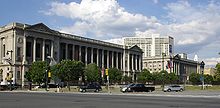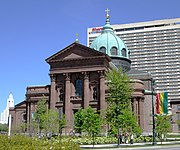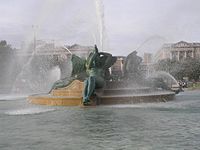
The Centennial International Exhibition, officially the International Exhibition of Arts, Manufactures, and Products of the Soil and Mine, was held in Philadelphia from May 10 to November 10, 1876. It was the first official world's fair to be held in the United States, and coincided with the centennial anniversary of the Declaration of Independence's adoption in Philadelphia on July 4, 1776.

Rittenhouse Square is a neighborhood, including a public park, in Center City Philadelphia, Pennsylvania. Rittenhouse Square often specifically refers to the park, while the neighborhood as a whole is referred to simply as Rittenhouse. The park is one of the five original open-space parks planned by William Penn and his surveyor Thomas Holme during the late 17th century.

Center City includes the central business district and central neighborhoods of Philadelphia, Pennsylvania, United States. It comprises the area that made up the City of Philadelphia prior to the Act of Consolidation, 1854, which extended the city borders to be coterminous with Philadelphia County.
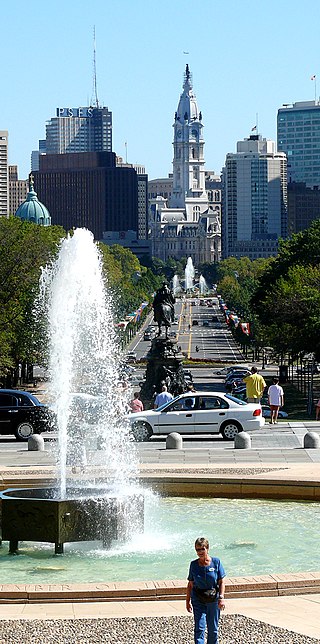
Benjamin Franklin Parkway, commonly abbreviated to Ben Franklin Parkway and colloquially called the Parkway, is a boulevard that runs through the cultural heart of Philadelphia, the nation's sixth-largest city as of 2020.

The Swann Memorial Fountain is an art deco fountain sculpture located in the center of Logan Circle in Philadelphia, Pennsylvania, United States.

Broad Street is a major arterial street in Philadelphia, Pennsylvania. The street runs for approximately 13 miles (21 km), beginning at the intersection of Cheltenham Avenue on the border of Cheltenham Township and the West/East Oak Lane neighborhoods of North Philadelphia to the Philadelphia Navy Yard in South Philadelphia. It is Pennsylvania Route 611 along its entire length with the exception of its northernmost part between Old York Road and Pennsylvania Route 309 and the southernmost part south of Interstate 95.

Logan Square is a neighborhood in Philadelphia, Pennsylvania, United States. Bounded by Market Street on the south, Spring Garden Street on the north, Broad Street on the east, and the Schuylkill River on the west, it occupies the northwestern quadrant of Center City. The square for which it is named is one of the five squares central to William Penn's design for Philadelphia. Originally called Northwest Square, it was renamed in honor of James Logan, an 18th-century mayor of Philadelphia.

Franklin Square is one of the five original open-space parks planned by William Penn when he laid out the city of Philadelphia, Pennsylvania, in 1682. It is located in the Center City area, between North 6th and 7th streets, and between Race Street and the Vine Street Expressway (I-676).
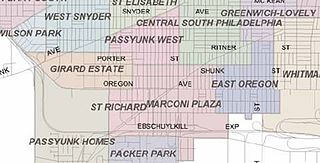
Marconi Plaza is an urban park square located in South Philadelphia, Philadelphia, Pennsylvania, United States. The plaza was named to recognize the 20th-century cultural identity in Philadelphia of the surrounding Italian American enclave neighborhood and became the designation location of the annual Columbus Day Parade.

Eakins Oval is a traffic circle in Philadelphia. It forms the northwest end of the Benjamin Franklin Parkway just in front of the Philadelphia Museum of Art, with a central array of fountains and monuments, and a network of pedestrian walkways.
SEPTA Route 38 is a bus and former Subway-Surface streetcar route operated by the Southeastern Pennsylvania Transportation Authority (SEPTA) in Philadelphia, Pennsylvania, United States.

Eli Kirk Price II was a prominent American Philadelphia lawyer, called "the foremost civic and cultural leader in early twentieth-century Philadelphia". He was the commissioner of Fairmount Park during the planning and development of the Benjamin Franklin Parkway, of which he was one of the principal planners. Later, he was instrumental in obtaining funding for the new Philadelphia Museum of Art building and was President of the museum from 1926 to 1933.
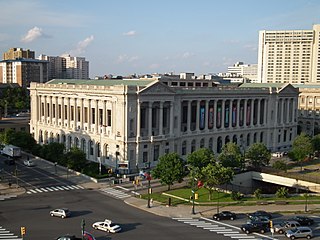
Vine Street is a major east-west street in Center City Philadelphia. It begins at the Delaware River and proceeds west to 20th Street, where it merges with the Benjamin Franklin Parkway.

Philadelphia Parks & Recreation (PPR) is the municipal department responsible for managing parks, recreation centers, playgrounds, trails, community gardens, and historic properties in Philadelphia, Pennsylvania. Its inventory includes more than 150 parks and 170 recreation centers and playgrounds. It became the successor to the Fairmount Park Commission and the City of Philadelphia Department of Recreation in 2010.

All Wars Memorial to Colored Soldiers and Sailors is a war memorial in Philadelphia, Pennsylvania that honors the state's African American servicemen who fought in American conflicts from the American Revolutionary War to World War I. Commissioned by the Commonwealth of Pennsylvania in 1927, it was created by sculptor J. Otto Schweizer and dedicated July 7, 1934. In 1994 it was relocated from a remote site in West Fairmount Park to its present prominent site in Logan Square, along the Benjamin Franklin Parkway.

Public drinking fountains in Philadelphia, Pennsylvania, United States, have been built and used since the 19th century. Various reform-minded organizations in the city supported public drinking fountains as street furniture for different but overlapping reasons. One was the general promotion of public health, in an era of poor water and typhoid fever. Leaders of the temperance movement such as the Woman's Christian Temperance Union saw free, clean water as a crucial alternative to beer. Emerging animal welfare organizations, notably the Society for the Prevention of Cruelty to Animals, wanted to provide water to the dogs and working horses of the city on humanitarian grounds, which is why Philadelphia's drinking fountains of the era often include curb-level troughs that animals could reach.
Wilson Cary Swann was an American physician, philanthropist, and social reformer. Born in present-day Alexandria, Virginia, he moved to Philadelphia in 1847, and spent the rest of his life there. Swann held around 40 slaves, whom he freed shortly after his marriage in 1847.




